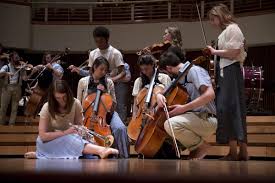
This past Saturday’s Saint Louis Symphony concert at Powell Hall became the stage for a peaceful protest of the Michael Brown shooting in Ferguson. A performance of Brahms’ German Requiem was delayed briefly as a flash mob throughout the hall began singing,
Justice for Mike Brown is Justice for us All,
Which side are you on, friend? Which side are you on?
The well-sung protest lasted about a minute before the group left the hall on their own. Some members of the audience and orchestra applauded in support of the protesters, who had purchased tickets for the performance. A banner, unfurled from the balcony, urged concertgoers to “Join the Movement.” There seems to be a general consensus that both the protesters and the Saint Louis Symphony handled the situation with dignity and respect.
But the protest also revealed some unfortunate stereotypes (and realities) about symphonic concerts and perceived class and ethnic divisions. In an article in yesterday’s Washington Post, Robert Samuels wrote that protesters “put on sports coats and fancy dresses and sat in on the St. Louis Symphony.” Quotes from one of the organizers of the flash mob suggested that the protest was an attempt to force wealthy members of the community out of their comfort zones towards an acknowledgment of the reality of racism. Both views seem to be built on the assumption that orchestra concerts are little more than social gatherings for wealthy elites. Nothing should be further from the truth. The Brahms Requiem and other masterworks have the power to speak to everyone and should be available to the entire community. At its core, listening to live music is a powerful individual experience, not a superficial social outing.
So what connections exist between politics, emotion and music? Often we assume that composers and performers are expressing their innermost feelings through music. However, music transcends politics, morality and individual expression to reach a reality which can be felt but cannot be put into words. Gustav Mahler described the experience of looking down at the page with the sensation that the music had not come from his intellect, but from somewhere else. In the most transcendent concerts, many musicians have experienced the rare and mysterious sensation of the music playing “through” them. At its essence, music isn’t about individual expression or the emotions of composers. It doesn’t tell stories. It goes beyond all of that, and in attuned moments, we find ourselves connected to a profound reality.
We are lived by powers we pretend to understand.
-W.H. Auden
Deep River
Here is legendary African-American contralto Marian Anderson (1897-1993) singing the spiritual, Deep River:

